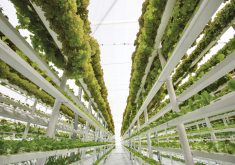More focus on the environment, more plant-based meat alternatives and more scrutiny of food production.
That’s what lies in the crystal ball of David Hughes, an international speaker on global food industry trends.
At a recent event hosted by the Plant Protein Alliance of Alberta, Hughes laid out a number of points that could be seen as negatives.
For example, a recent survey found 89 per cent of respondents are reducing their meat consumption for their health, while 39 said they are reducing meat consumption for the environment.

“The older you are, the more likely you are to think about reducing your meat consumption for personal health reasons,” said Hughes. “The younger you are, the more it tends to be about the environment or animal welfare.”
Global food giants, such as Unilever, are grabbing up small players, such as The Vegetarian Butcher, and using their marketing clout to get them into grocery chains and drive sales higher.
“This is broad-scale stuff. In my professional life, I’ve never seen such a rush to market,” said Hughes.
The main target for these foods are flexitarians, who still eat meat, but want to eat more plant-based foods as well.
“This is not about people turning vegetarian or vegan, this is about changing the diet or finding better balance in the diet,” he said.
Read Also

Recommendations in the mature assets strategy could cause potential problems for landholders
The Western Stock Growers’ Association urges producers to pay attention to the potential changes to Alberta’s Mature Assets Strategy.
Then there’s the burgeoning popularity of ‘climate-friendly’ diets, part of a trend in which people — particularly younger ones — seek out information about the impact of food production on the environment to make purchasing decisions.
That growing interest in agriculture is prompting mainstream publications such as The New York Times and The Economist to start covering agricultural issues, said Hughes.
“The profile of agriculture is going up and is continuing to do so,” he said.
The other side
This is good news for producers and processors of crops such as pulses.
“There’s a protein umbrella,” he told his audience of Plant Protein Alliance members and other interested guests. “That umbrella is getting bigger and bigger from a consumer perspective. Their perception of what protein is keeps expanding.
“The largest proportion of protein under this umbrella is plant protein and it always was.”
But the situation isn’t bad for those in the meat business, either, he added.
While demand for plant protein is growing in more affluent markets, it’s not rising as fast as demand for meat protein in emerging markets.
“Overall, protein in the world is growing at an accelerated rate and it’s both plant and meat,” said Hughes. “The protein umbrella is trillions of dollars. But from a meat industry point of view, you shouldn’t panic. It’s just a matter of what (share) plant based will take.”
Rise of mega-cities
Underlying these trends are even more powerful demographic ones.
While regions such as Europe are seeing populations fall, the global south is quickly gaining people. Coupled with increasing urbanization, this is creating the rise of mega-cities. (Definitions of a mega-city vary — some say at least 10 million residents, others put the threshold at half that.) But Hughes said mega-cities are becoming a new normal.
“We’ll build an entire New York City every month for 40 years, if you look at what’s happening in global urbanization,” he said.
While marketers are now focused on countries, their attention will shift to these very large urban areas, which are projected to number in the hundreds. Marketers will soon be able to focus on the wants and preferences of Shanghai residents, rather than the entire Chinese market, for example.
The changing consumer
Shoppers everywhere are changing, too, said Hughes
They are time optimizers, health conscious, want to be treated as individuals, and are more experimental and socially conscious.
They are also increasingly interested in storytelling and where their food and food ingredients come from.
“I think this is really important to Alberta and the Prairie provinces,” said Hughes.
People are no longer as interested in brands, but more interested in ingredients and how they were produced.
“I would say you have a great integrity of producers and a great supply chain,” he said. “You have a real story to tell.”
However, expect environmental scores to become common on all food products, something that is well underway in the U.S. and U.K.
“It’s coming and it’s coming big time,” he said. “It’s happening in the private sector even before governments seem to think we should have some regulation on this.”
Consumers are tailoring their purchasing behaviour to environmental issues. That’s especially true among more affluent ones — lower-income people share those concerns but don’t have the same ability to buy eco-friendly products if the price tag is higher, he noted.
But that’s something that’s good for producers here, too, said Hughes.
“I know people would feel better consuming things from the Prairie provinces which have a legacy of food safety and food integrity,” he said.
















